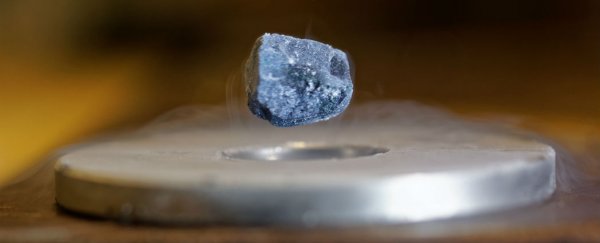An international team of scientists has announced the discovery of a new state of matter in a material that appears to be an insulator, superconductor, metal and magnet all rolled into one, saying that it could lead to the development of more effective high-temperature superconductors.
Why is this so exciting? Well, if these properties are confirmed, this new state of matter will allow scientists to better understand why some materials have the potential to achieve superconductivity at a relativity high critical temperature (Tc) - "high" as in −135 °C as opposed to −243.2 °C. Because superconductivity allows a material to conduct electricity without resistance, which means no heat, sound, or any other form of energy release, achieving this would revolutionise how we use and produce energy, but it's only feasible if we can achieve it at so-called high temperatures.
As Michael Byrne explains at Motherboard, when we talk about states of matter, it's not just solids, liquids, gases, and maybe plasmas that we have to think about. We also have to consider the more obscure states that don't occur in nature, but are rather created in the lab - Bose–Einstein condensate, degenerate matter, supersolids and superfluids, and quark-gluon plasma, for example.
By introducing rubidium into carbon-60 molecules - more commonly known as 'buckyballs' - a team led by chemist Kosmas Prassides from Tokohu University in Japan was able to change the distance between them, which forced them into a new, crystalline structure. When put through an array of tests, this structure displayed a combination of insulating, superconducting, metallic, and magnetic phases, including a brand new one, which the researchers have named 'Jahn-Teller metals'.
Named after the Jahn-Teller effect, which is used in chemistry to describe how at low pressures, the geometric arrangement of molecules and ions in an electronic state can become distorted, this new state of matter allows scientists to transform an insulator - which can't conduct electricity - into a conductor by simply applying pressure. Byrne explains at Motherboard:
"This is what the rubidium atoms do: apply pressure. Usually when we think about adding pressure, we think in terms of squeezing something, forcing its molecules closer together by brute force. But it's possible to do the same thing chemically, tweaking the distances between molecules by adding or subtracting some sort of barrier between them - sneaking in some extra atoms, perhaps.
What happens in a Jahn-Teller metal is that as pressure is applied, and as what was previously an insulator - thanks to the electrically-distorting Jahn-Teller effect - becomes a metal, the effect persists for a while. The molecules hang on to their old shapes. So, there is an overlap of sorts, where the material still looks an awful lot like an insulator, but the electrons also manage to hop around as freely as if the material were a conductor."
And it's this transition phase between insulator and conductor that, until now, scientists have never seen before, and hints at the possibility of transforming insulating materials into super-valuable superconducting materials. And this buckyball crystalline structure appears to be able to do it at a relatively high TC. "The relationship between the parent insulator, the normal metallic state above Tc, and the superconducting pairing mechanism is a key question in understanding all unconventional superconductors," the team writes in Science Advances.
There's a whole lot of lab-work to be done before this discovery will mean anything for practical energy production in the real world, but that's science for you. And it's got people excited already, as chemist Elisabeth Nicol from the University of Guelph in Canada told Hamish Johnston at PhysicsWorld: "Understanding the mechanisms at play and how they can be manipulated to change the Tc surely will inspire the development of new [superconducting] materials".
